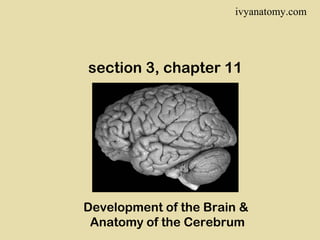
Brain Anatomy & Development
- 1. ivyanatomy.com section 3, chapter 11 Development of the Brain & Anatomy of the Cerebrum
- 2. The Brain The brain has many functions. sensations and perceptions memory reasoning decision making commands skeletal muscles regulates visceral activities provides personality The major parts of the brain: Cerebrum Diencephalon Cerebellum Brainstem Midbrain Pons Medulla oblongata
- 3. The Brain Figure 11.15b. Sagittal section of human brain. The major portions include the cerebrum, the diencephalon, the cerebellum, and the brainstem. The brainstem includes the midbrain, the pons, and the medulla oblongata.
- 4. Brain Development The central nervous system develops from a neural tube that gives rise to the brain and spinal cord. The brain begins as three primary vesicles 1.prosencephalon – forebrain 2.mesencephalon – midbrain 3.rhombencephalon – hindbrain Later the brain divides into five secondary vesicles The prosencephalon divides into the telencephalon & diencephalon. The mesencephalon remains as the midbrain. The rhombencephalon divides into the metencephalon & myelencephalon
- 5. Brain Development Five secondary vesicles: Telencephalon Diencephalon Mesencephalon Metencephalon Myelencephalon
- 6. Brain Development Eventually the vesicles give rise to regions of the brain: telencephalon gives rise to the cerebrum and basal nuclei diencephalon gives rise to the thalamus, hypothalamus, and pituitary gland mesencephalon becomes the midbrain metencephalon forms the pons and cerebellum myelencephalon forms the medulla oblongata.
- 8. functions of the cerebrum The cerebrum provides higher brain functions: 1.Interpreting senses 2.Voluntary muscle movements 3.Memory 4.Reasoning 5.Intelligence 6.Personality Colors distinguish the lobes of the cerebral hemisphere. (a) lateral view. (b) superior view
- 9. anatomy of the cerebrum The cerebrum consists of a left and right hemisphere separated by a longitudinal fissure. A bridge of nerve fibers called the cporus callosum connects the two cerebral hemispheres. A transverse fissure separates the cerebrum from the cerebellum. The surface of the cerebrum contains many ridges and grooves. Gyri (sing. gyrus) = Bumps or convolutions Sulci (sing. Sulcus)= Grooves in cerebrum
- 10. Lobes of the cerebrum The cerebrum is divided into five (5) lobes bilaterally: Frontal lobe Parietal lobe Temporal lobe Occipital lobe Insula – deep lobe Figure 11.16(c) lateral view of the cerebrum using colors to distinguish the individual lobes. The temporal lobe is retracted to expose the deeper insula.
- 11. Functional regions of the cerebral cortex The cerebral cortex is a thin outer layer of gray matter in the cerebrum. • contains 75% of all neurons in the nervous system The cerebral medulla is a thick layer of white matter underlying the cortex. •bulk of cerebrum •contains masses of gray matter (nuclei)
- 12. Functional regions of the cerebral cortex Sensory Areas – cerebrum interprets impulses from receptors Motor Areas – cerebrum controls voluntary motor actions Association Areas - cerebrum connects from one region of the brain to another • Thoughts, emotions, and understanding
- 13. Functions of the frontal lobes Frontal Lobes Association areas = prefrontal cortex higher intellect: judgment, complex problem solving, planning, and decision making Motor areas = voluntary motor control Frontal eye field – voluntary movements of eyes Broca’s area – coordinates mouth, tongue, and pharynx for speech • Damage may result in patient being unable to form complete sentences. Primary motor cortex (precentral gyrus) – motor areas involved with control of voluntary cells within the frontal lobe that Pyramidal cells - muscles initiate voluntary movements
- 14. Functions of the parietal lobes Sensory areas of the parietal lobes Post-central gyrus (primary somatosensory cortex)– sensory areas involved with touch, temperature, pain and other cutaneous senses Wernike’s Area – sensory speech area. Choosing words to express thoughts and emotionsUsually within left hemisphere. Association areas General interpretive area (Wernike’s area) - integrates visual, auditory, and other sensory information an then interprets a situation.
- 15. Figure 11.18. Functional regions of the cerebral cortex. (a)motor areas that control voluntary muscles. (b)sensory areas involved with cutaneous and other senses.
- 16. Functions of the temporal and occipital lobes Temporal Lobes • Sensory Areas • Hearing and smell (smell within deep temporal lobe) •Association areas – interpret complex sensory experiences • Understand speech and reading • Stores memories of visual scenes, music, and other sensory patterns Occipital Lobes •Visual Cortex - vision •Visual association Combines visual images with other experiences – face recognition
- 18. Hemisphere Dominance The left hemisphere is dominant in most individuals The dominant hemisphere controls: • Speech, reading and writing • Analytical and computational skills The non-dominant hemisphere controls: • Motor tasks and other non-verbal tasks •Provides emotional and intuitive thought processes Corpus callosum enables the dominant hemisphere to control the motor cortex in the nondominant hemisphere. It also relays sensory information reaching the nondominant hemisphere to the dominant hemisphere to be interpreted.
- 19. Basal Nuclei The basal nuclei are three masses of grey matter deep within the cerebrum: 1. Caudate nucleus 2. Putamen 3. Globus pallidus The basal nuclei secrete the inhibitory neurotransmitter dopamine • Basal nuclei interact with a region in the midbrain, called Substantia Nigra • Basal nuclei & substantia nigra facilitate voluntary movements
- 20. Parkinson’s Disease Parkinson’s Disease (PD) results occurs from degeneration of the basal nuclei and the substantia nigra. This results in a deficiency of dopamine. Symptoms include: • tremors at rest • poor small muscle control • rigidity • difficulties speaking End of section 3, chapter 11 Figure 11D. Muhammad Ali has PD from many years of head injuries as a boxer. Michael J. Fox first experienced symptoms of PD at age 29, which is unusual.